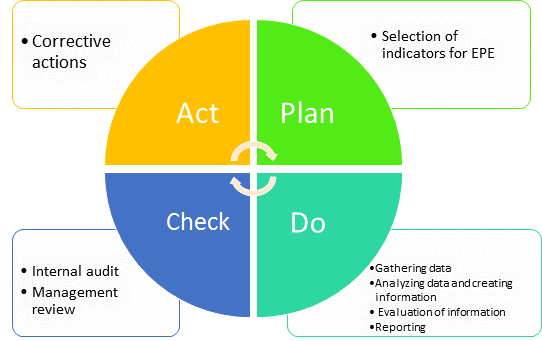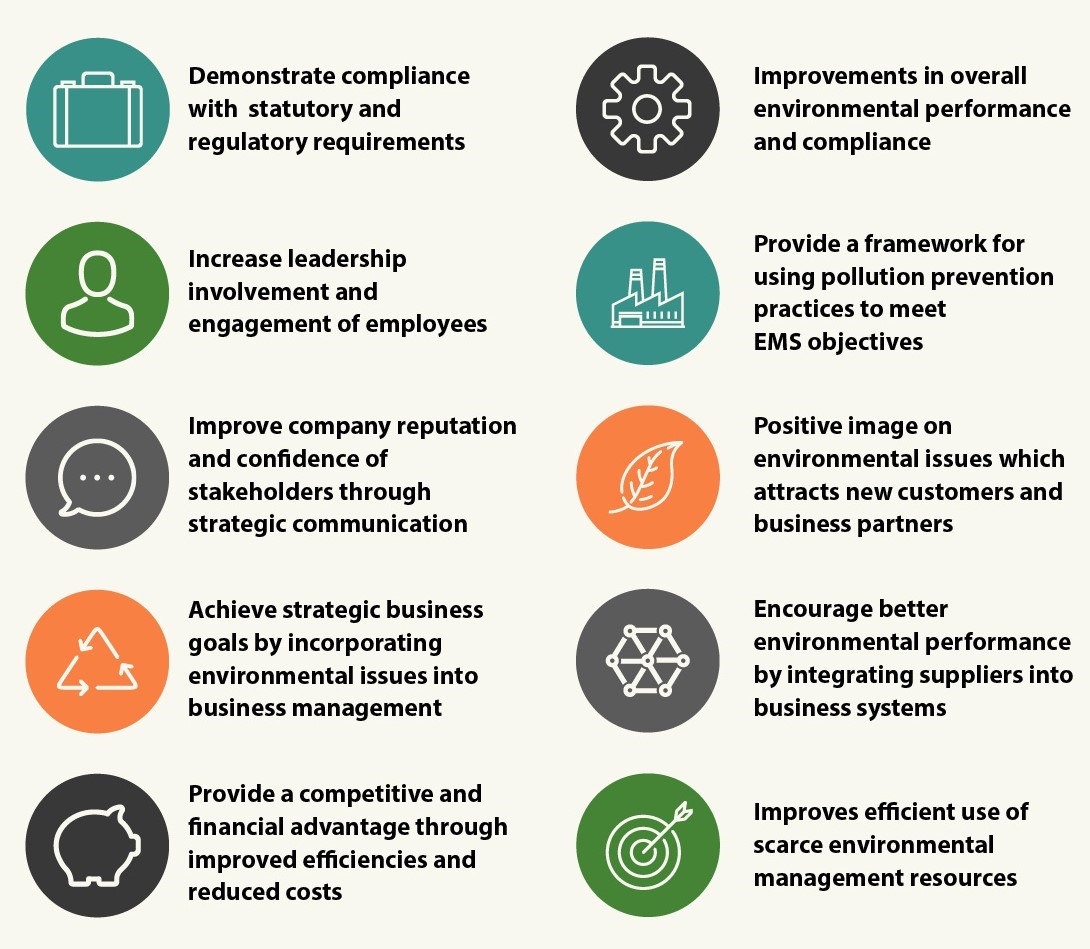ISO 14001:2015 Environmental Management System
ISO 14001 Environmental Management System (EMS) is a systematic framework to manage the immediate and long-term environmental impacts of an organization’s products, services and processes. By completing ISO 14001 certification your organization can assure stakeholders that your environmental management system meets international industry specific environmental standards.
ISO 14001:2015 helps an organization achieve the intended outcomes of its environmental management system, which provide value for the environment, the organization itself and interested parties. Consistent with the organization’s environmental policy, the intended outcomes of an environmental management system include:
- Enhancement of environmental performance;
- Fulfilment of compliance obligations;
- Achievement of environmental objectives.
ISO 14001:2015 is applicable to any organization, regardless of size, type and nature, and applies to the environmental aspects of its activities, products and services that the organization determines it can either control or influence considering a life cycle perspective. ISO 14001:2015 does not state specific environmental performance criteria.
ISO 14001:2015 can be used in whole or in part to systematically improve environmental management. Claims of conformity to ISO 14001:2015, however, are not acceptable unless all its requirements are incorporated into an organization’s environmental management system and fulfilled without exclusion.
BENEFITS OF ISO 14001
- Identify cost savings with greater emphasis on resource, waste and energy management
- Develop corporate image and credibility
- Quantify, monitor and control the impact of operations on the environment, now and in the future
- Ensure legislative awareness and compliance
- Improve environmental performance of supply chain
- Protect the company, assets, shareholders and directors
- Potentially decrease public liability insurance costs for your organization
- Grow your access to business partners and potential customers
What industries implement ISO 14001:2015?
Every company large and small (industrial, manufacturing, services, or trade related) has an impact on the environment and can therefore benefit from certification.
PDCA cycle
 ISO 14001 Clauses
ISO 14001 Clauses
Clause 1: Scope
This clause relates to the scope or coverage of the standard to help organizations achieve the intended outcomes of its EMS. It references undertaking environmental management that includes a consideration of a ‘life cycle perspective’.
Clause 2: Normative reference
There are no normative references, for example other additional requirements in other standards, that have to be considered. The clause is retained in order to maintain the same numbering scheme as all the other management system standards.
Clause 3: Terms and definitions
At first sight, the listing of terms and definitions seems confusing as they are not in alphabetical order. Instead, the approach stipulated by ISO and new to many users, is that terms and definitions have been grouped into organization and leadership, planning, support and operation and performance evaluation and improvement. It may be easier to use this listing in conjunction with the alphabetical listing in Annex C.
Clause 4: Context of the organization
This is a new clause that establishes the context of the EMS and how the business strategy supports this. ‘Context of the organization’ is the clause that underpins the rest of the standard. It gives an organization the opportunity to identify and understand the factors and parties that can affect, either positively or negatively, the EMS. Firstly, the organization will need to determine external and internal issues that are relevant to its purpose i.e. what are the relevant issues, both inside and out, that have an impact on or affect its ability to achieve the intended outcome(s) of the EMS. Importantly, issues should include not only environmental conditions that the organization affects but also those that it is affected by. Secondly, an organization will also need to identify the ‘interested parties’ relevant to their EMS, which could include customers, communities, suppliers and non-government organizations. Determining their relevant needs and expectations is part of establishing the context for the EMS. Each organization will identify their own unique set of ‘interested parties’ and these may change over time. Finally, the last requirement is to establish, implement, maintain and continually improve the EMS in accordance with the requirements of the standard.
Clause 6: Planning
This clause focuses on how an organization plans actions to address both risks and opportunities which have been identified in Clause 4. It focuses the organization on the development and use of a planning process, rather than a procedure to address both a range of factors and the risk associated with such factors. Consideration of risks needs to be proportionate to the potential impact they may have, and opportunities could include substitute raw materials for example. For the first time, there is an explicit reference to abnormal and emergency situations. Even more importantly, the reference to a consideration of a life cycle perspective and the clause notes highlights that significant aspects can give rise to risks that are both beneficial and adverse. Another key area of this clause is the need to establish measurable environmental objectives. Finally this clause covers what is referred to as “planning of changes”. This has to be done in a systematic manner. Organizations should consider identifying who is involved, when changes are to take place and the potential consequences of change.
Clause 7: Support
This clause is all about the execution of the plans and processes that enable an organization to meet their EMS. Simply expressed, this is a very powerful requirement covering all EMS resource needs. Organizations will need to determine the necessary competence of people doing work that, under its control, affects its environmental performance, its ability to fulfil its compliance obligations and ensure they receive the appropriate training. In addition, organizations need to ensure that all people doing work under the organization’s control are aware of the environmental policy, how their work may impact this and implications of not conforming with the EMS. Finally, there are the requirements for ‘documented information’ which relate to the creation, updating and control of specific data.
Clause 8: Operation
This clause deals with the execution of the plans and processes that enable the organization to meet their environmental objectives. There are specific requirements that relate to the control or influence exercised over outsourced processes and the requirement to consider certain operational aspects ‘consistent with a life cycle perspective’. This 6 means giving serious consideration to how actual or potential environmental impacts happening upstream and downstream of an organization’s site-based operations are influenced or (where possible) controlled. Finally, the clause also covers the procurement of products and services, as well as controls to ensure that environmental requirements relating to design, delivery, use and end-of-life treatment of an organization’s products and services are considered at an appropriate stage.
Clause 9: Performance Evaluation
This is all about measuring and evaluating your EMS to ensure that it is effective and it helps you to continually improve. You will need to consider what should be measured, the methods employed and when data should be analysed and reported on. As a general recommendation, organizations should determine what information they need to evaluate environmental performance and effectiveness. Internal audits will need to be carried out, and there are certain “audit criteria” that are defined to ensure that the results of these audits are reported to relevant management. Finally, management reviews will need to be carried out and “documented information” must be kept as evidence.
Clause 10: Improvement
This clause requires organizations to determine and identify opportunities for continual improvement of the EMS. The requirement for continual improvement has been extended to ensure that the suitability and adequacy of the EMS—as well as its effectiveness— are considered in the light of enhanced environmental performance. There are some actions that are required that cover handling of corrective actions. Firstly, organizations need to react to the nonconformities and take action. Secondly, they need to identify whether similar nonconformities exist or could potentially occur. This clause requires organizations to determine and identify opportunities for continual improvement of the EMS. There is a requirement to actively look out for opportunities to improve processes, products or services; particularly with future customer requirements in mind.
Mandatory documents and records required 14001:
- Scope of the EMS(clause 4.3)
- Environmental policy(clause 5.2)
- Risk and opportunities to be addressed and processes needed(clause 6.1.1)
- Criteria for evaluation of significant environmental aspects(clause 6.1.2)
- Environmental aspects with associated environmental impacts(clause 6.1.2)
- Significant environmental aspects(clause 6.1.2)
- Environmental objectives and plans for achieving them(clause 6.2)
- Operational control(clause 8.1)
- Emergency preparedness and response(clause 8.2)
- Compliance obligations record(clause 6.1.3)
- Records of training, skills, experience and qualifications(clause 7.2)
- Evidence of communication(clause 7.4)
- Monitoring and measurement results(clause 9.1.1)
- Internal audit program(clause 9.2)
- Results of internal audits(clause 9.2)
- Results of the management review(clause 9.3)
- Results of corrective actions(clause 10.1)
- Procedure for determining context of the organization and interested parties(clauses 4.1 and 4.2)
- Procedure for identification and evaluation of environmental aspects and risks(clauses 6.1.1 and 6.1.2)
- Competence, training and awareness procedure(clauses 7.2 and 7.3)
- Procedure for communication(clause 7.4)
- Procedure for document and record control(clause 7.5)
- Procedure for internal audit(clause 9.2)
- Procedure for management review(clause 9.3)
- Procedure for management of nonconformities and corrective actions (clause 10.2)

